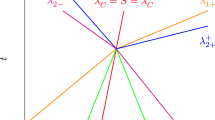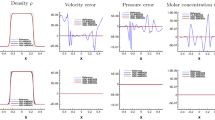Abstract
The use of complex multi-parameter equations of state in computational fluid dynamics is limited due to their expensive evaluation. Tabulation methods help to overcome this limitation. We propose in this work a tabulation approach for real equations of state that is also suitable for multi-component flows and multi-phase flows with phase transition based on the homogeneous equilibrium method. The tabulation method is based on piecewise polynomials and allows adaptive refinement in state space, a local variation of the degree of the polynomials and even cut-cells to represent saturation lines. A detailed analysis of the benefits of the chosen tabulation approach is provided showing results of benchmark problems for nitrogen under sub- and trans-critical conditions. The tables are used in numerical simulations based on the finite volume approach. To provide reference solutions, an exact Riemann solver is constructed for the tabulated real EOS. Several numerical flux calculations based on approximate Riemann solutions and flux vector splitting approaches are modified for the tabulated equation of state. Besides the comparison for benchmark problems, two applications are depicted, a shock–bubble interaction and an injection of a trans-critical jet, which demonstrate the applicability of this approach to more complex flow simulations.






















Similar content being viewed by others
Notes
CoolProp v6.1.
RefProp v9.1.
References
De Lorenzo, M., Lafon, P., Di Matteo, M., Pelanti, M., Seynhaeve, J.M., Bartosiewicz, Y.: Homogeneous two-phase flow models and accurate steam-water table look-up method for fast transient simulations. Int. J. Multiph. Flow 95, 199–219 (2017). https://doi.org/10.1016/j.ijmultiphaseflow.2017.06.001
Praneeth, S., Hickey, J.-P.: Uncertainty quantification of tabulated supercritical thermodynamics for compressible Navier–Stokes solvers (2018). arXiv:1801.06562 [physics.comp-ph]
Dumbser, M., Iben, U., Munz, C.D.: Efficient implementation of high order unstructured WENO schemes for cavitating flows. Comput. Fluids 86, 141–168 (2013). https://doi.org/10.1016/j.compfluid.2013.07.011
Roe, P.: Approximate Riemann solvers, parameter vectors, and difference schemes. J. Comput. Phys. 43(2), 357–372 (1981). https://doi.org/10.1016/0021-9991(81)90128-5
Toro, E.: Riemann Solvers and Numerical Methods for Fluid Dynamics: A Practical Introduction. Springer, Berlin (2009). https://doi.org/10.1007/b79761
Liou, M.S.: A sequel to AUSM, Part II: AUSM\(^+\)-up for all speeds. J. Comput. Phys. 214(1), 137–170 (2006). https://doi.org/10.1016/j.jcp.2005.09.020
Flexi—description and source code. https://www.flexi-project.org/. Accessed 02 Oct 2018
Hindenlang, F., Gassner, G., Altmann, C., Beck, A., Staudenmaier, M., Munz, C.: Explicit discontinuous Galerkin methods for unsteady problems. Comput. Fluids 61, 86–93 (2012). https://doi.org/10.1016/j.compfluid.2012.03.006
Sonntag, M., Munz, C.D.: Efficient parallelization of a shock capturing for discontinuous Galerkin methods using finite volume sub-cells. J. Sci. Comput. 70(3), 1262–1289 (2017). https://doi.org/10.1007/s10915-016-0287-5
Dumbser, M., Zanotti, O., Loubère, R., Diot, S.: A posteriori subcell limiting of the discontinuous Galerkin finite element method for hyperbolic conservation laws. J. Comput. Phys. 278, 47–75 (2014). https://doi.org/10.1016/j.jcp.2014.08.009
Bell, I., Wronski, J., Quoilin, S., Lemort, V.: Pure and pseudo-pure fluid thermophysical property evaluation and the open-source thermophysical property library CoolProp. Ind. Eng. Chem. Res. 53(6), 2498–2508 (2014). https://doi.org/10.1021/ie4033999
Lemmon, E., Huber, M., McLinden, M.: NIST standard reference database 23: Reference fluid thermodynamic and transport properties-REFPROP, Gaithersburg (2013)
Stewart, H.B., Wendroff, B.: Two-phase flow: Models and methods. J. Comput. Phys. 56(3), 363–409 (1984). https://doi.org/10.1016/0021-9991(84)90103-7
Coffee, T., Heimerl, J.: Transport algorithms for premixed, laminar steady-state flames. Combust. Flame 43, 273–289 (1981). https://doi.org/10.1016/0010-2180(81)90027-4
Kunz, O., Klimeck, R., Wagner, W., Jaeschke, M.: The GERG-2004 Wide-range Equation of State for Natural Gases and Other Mixtures. VDI-Verlag, Düsseldorf, Ber. VDI (2007)
Kunz, O., Wagner, W.: The GERG-2008 wide-range equation of state for natural gases and other mixtures: An expansion of GERG-2004. J. Chem. Eng. Data 57(11), 3032–3091 (2012). https://doi.org/10.1021/je300655b
Younglove, B.A.: Thermophysical properties of fluids. I. Argon, ethylene, parahydrogen, nitrogen, nitrogen trifluoride, and oxygen. Technical Report, National Standard Reference Data System (1982)
Bell, I.H., Wronski, J., Quoilin, S., Lemort, V.: Pure and pseudo-pure fluid thermophysical property evaluation and the open-source thermophysical property library CoolProp. Ind. Eng. Chem. Res. 53(6), 2498–2508 (2014). https://doi.org/10.1021/ie4033999. http://www.coolprop.org
Lemmon, E.W., Huber, M.L., McLinden, M.O.: NIST standard reference database 23: Reference fluid thermodynamic and transport properties-REFPROP, version 9.1. National Standard Reference Data Series (NIST NSRDS) (2013)
Span, R.: Multiparameter Equations of State. Springer, Berlin (2000). https://doi.org/10.1007/978-3-662-04092-8
Span, R., Lemmon, E.W., Jacobsen, R.T., Wagner, W., Yokozeki, A.: A reference equation of state for the thermodynamic properties of nitrogen for temperatures from 63.151 to 1000 K and pressures to 2200 MPa. J. Phys. Chem. Ref. Data 29(6), 1361–1433 (2000). https://doi.org/10.1063/1.1349047
Aursand, P., Gjennestad, M.A., Aursand, E., Hammer, M., Wilhelmsen, Ø.: The spinodal of single- and multi-component fluids and its role in the development of modern equations of state. Fluid Phase Equilib. 436, 98–112 (2017). https://doi.org/10.1016/j.fluid.2016.12.018
Menikoff, R., Plohr, B.J.: The Riemann problem for fluid flow of real materials. Rev. Mod. Phys. 61, 75–130 (1989). https://doi.org/10.1103/RevModPhys.61.75
Edwards, J.R., Franklin, R.K., Liou, M.S.: Low-diffusion flux-splitting methods for real fluid flows with phase transitions. AIAA J. 38(9), 1624–1633 (2000). https://doi.org/10.2514/2.1145
Hempert, F., Boblest, S., Ertl, T., Sadlo, F., Offenhäuser, P., Glass, C., Hoffmann, M., Beck, A., Munz, C., Iben, U.: Simulation of real gas effects in supersonic methane jets using a tabulated equation of state with a discontinuous Galerkin spectral element method. Comput. Fluids 145, 167–179 (2017). https://doi.org/10.1016/j.compfluid.2016.12.024
Thorade, M., Saadat, A.: Partial derivatives of thermodynamic state properties for dynamic simulation. Environ. Earth Sci. 70(8), 3497–3503 (2013). https://doi.org/10.1007/s12665-013-2394-z
Saurel, R., Petitpas, F., Abgrall, R.: Modelling phase transition in metastable liquids: Application to cavitating and flashing flows. J. Fluid Mech. 607, 313–350 (2008). https://doi.org/10.1017/S0022112008002061
Traxinger, C., Banholzer, M., Pfitzner, M.: Real-gas effects and phase separation in underexpanded jets at engine-relevant conditions. 2018 AIAA Aerospace Sciences Meeting, Kissimmee, Florida, AIAA Paper 2018-1815 (2018). https://doi.org/10.2514/6.2018-1815
Wood, A.B.: Textbook of Sound. G. Bell And Sons Ltd, London (1930)
Matheis, J., Hickel, S.: Multi-component vapor–liquid equilibrium model for les of high-pressure fuel injection and application to ECN spray A. Int. J. Multiph. Flow 99, 294–311 (2018). https://doi.org/10.1016/j.ijmultiphaseflow.2017.11.001
The isothermal flash problem: Michelsen, M.L. Part I. stability. Fluid Phase Equilib. 9, 1–19 (1982). https://doi.org/10.1016/0378-3812(82)85001-2
Gernert, J., Jäger, A., Span, R.: Calculation of phase equilibria for multi-component mixtures using highly accurate Helmholtz energy equations of state. Fluid Phase Equilib. 375, 209–218 (2014). https://doi.org/10.1016/j.fluid.2014.05.012
Bassi, F., Rebay, S.: A high-order accurate discontinuous finite element method for the numerical solution of the compressible Navier–Stokes equations. J. Comput. Phys. 131(2), 267–279 (1997). https://doi.org/10.1006/jcph.1996.5572
Bassi, F., Rebay, S.: Numerical evaluation of two discontinuous Galerkin methods for the compressible Navier–Stokes equations. Int. J. Numer. Methods Fluids 40(1–2), 197–207 (2002). https://doi.org/10.1002/fld.338
Kennedy, C.A., Carpenter, M.H., Lewis, R.: Low-storage, explicit Runge–Kutta schemes for the compressible Navier–Stokes equations. Appl. Numer. Math. 35(3), 177–219 (2000). https://doi.org/10.1016/S0168-9274(99)00141-5
Larrouturou, B.: How to preserve the mass fractions positivity when computing compressible multi-component flows. J. Comput. Phys. 95(1), 59–84 (1991). https://doi.org/10.1016/0021-9991(91)90253-H
Godunov, S.K.: A difference method for numerical calculation of discontinuous solutions of the equations of hydrodynamics. Mat. Sb. (N.S.) 47(89), 271–306 (1959)
Colella, P., Glaz, H.M.: Efficient solution algorithms for the Riemann problem for real gases. J. Comput. Phys. 59(2), 264–289 (1985). https://doi.org/10.1016/0021-9991(85)90146-9
Müller, S., Voss, A.: The Riemann problem for the Euler equations with nonconvex and nonsmooth equation of state: Construction of wave curves. SIAM J. Sci. Comput. 28(2), 651–681 (2006). https://doi.org/10.1137/040619909
Dahmen, W., Müller, S., Voß, A.: Riemann Problem for the Euler Equation with Non-convex Equation of State Including Phase Transitions. In: Warnecke, G. (ed.) Analysis and Numerics for Conservation Laws, pp. 137–162. Springer, Berlin (2005). https://doi.org/10.1007/3-540-27907-5_7
Smith, R.G.: The Riemann problem in gas dynamics. Trans. Am. Math. Soc. 249(1), 1–50 (1979). https://doi.org/10.2307/1998910
Kamm, J.R.: An exact, compressible one-dimensional Riemann solver for general, convex equations of state. Technical Report LA-UR-15-21616, Los Alamos National Laboratory (2015). https://doi.org/10.2172/1172220
Brent, R.: Algorithms for Minimization Without Derivatives. Dover Books on Mathematics. Dover Publications, New York (1973)
Abgrall, R.: An extension of Roe’s upwind scheme to algebraic equilibrium real gas models. Comput. Fluids 19(2), 171–182 (1991). https://doi.org/10.1016/0045-7930(91)90032-D
Roe, P.L., Pike, J.: Efficient construction and utilisation of approximate Riemann solutions. Proceeding of the 6th International Symposium on Computing Methods in Applied Sciences and Engineering, VI, pp. 499–518. North-Holland Publishing Co., Amsterdam (1985)
Harten, A., Lax, P., Leer, B.: On upstream differencing and Godunov-type schemes for hyperbolic conservation laws. SIAM Rev. 25(1), 35–61 (1983). https://doi.org/10.1137/1025002
Chang, C.-H., Liou, M.S.: A robust and accurate approach to computing compressible multiphase flow: Stratified flow model and AUSM+-up scheme. J. Comput. Phys. 225(1), 840–873 (2007). https://doi.org/10.1016/j.jcp.2007.01.007
Kitamura, K., Liou, M.S.: Comparative study of AUSM-family schemes in compressible multiphase flow simulations. ICCFD7-3702, 7th International Conference on Computational Fluid Dynamics (ICCFD7), Hawaii (2012)
Liou, M.S.: A sequel to AUSM: AUSM\(^+\). J. Comput. Phys. 129(2), 364–382 (1996). https://doi.org/10.1006/jcph.1996.0256
Lemmon, E.W., Jacobsen, R.T., Penoncello, S.G., Friend, D.G.: Thermodynamic properties of air and mixtures of nitrogen, argon, and oxygen from 60 to 2000 K at pressures to 2000 MPa. J. Phys. Chem. Ref. Data 29(3), 331–385 (2000). https://doi.org/10.1063/1.1285884
Abgrall, R., Karni, S.: Computations of compressible multifluids. J. Comput. Phys. 169(2), 594–623 (2001). https://doi.org/10.1006/jcph.2000.6685
Quirk, J.J., Karni, S.: On the dynamics of a shock-bubble interaction. J. Fluid Mech. 318, 129–163 (1996). https://doi.org/10.1017/S0022112096007069
Mayer, W., Telaar, J., Branam, R., Schneider, G., Hussong, J.: Raman measurements of cryogenic injection at supercritical pressure. Heat Mass Transf. 39(8), 709–719 (2003). https://doi.org/10.1007/s00231-002-0315-x
Ma, P.C., Lv, Y., Ihme, M.: An entropy-stable hybrid scheme for simulations of transcritical real-fluid flows. J. Comput. Phys. 340, 330–357 (2017). https://doi.org/10.1016/j.jcp.2017.03.022
Lemmon, E.W., Jacobsen, R.T.: Viscosity and thermal conductivity equations for nitrogen, oxygen, argon, and air. Int. J. Thermophys.25(1), 21–69 (2004). https://doi.org/10.1023/B:IJOT.0000022327.04529.f3
Venkatarathnam, G., Oellrich, L.: Identification of the phase of a fluid using partial derivatives of pressure, volume, and temperature without reference to saturation properties: Applications in phase equilibria calculations. Fluid Phase Equilib. 301(2), 225–233 (2011). https://doi.org/10.1016/j.fluid.2010.12.001
Acknowledgements
The work was supported by the German Research Foundation (DFG) through SFB TRR 40 “Technological Foundations for the Design of Thermally and Mechanically Highly Loaded Components of Future Space Transportation Systems,” SFB TRR 75 “Droplet Dynamics under Extreme Ambient Conditions,” and GRK 2160/1 “Droplet Interaction Technologies.” The simulations were performed on the national supercomputer Cray XC40 (Hazel Hen) at the High Performance Computing Center Stuttgart (HLRS) under the Grant No. hpcmphas/44084. M.D. also acknowledges funding via the European Union’s Horizon 2020 Research and Innovation Programme under the Project ExaHyPE, Grant No. 671698 (call FETHPC-1-2014), and financial support from the Italian Ministry of Education, University and Research (MIUR) in the frame of the Departments of Excellence Initiative 2018–2022 attributed to DICAM of the University of Trento.
Author information
Authors and Affiliations
Corresponding author
Additional information
Communicated by C.-H. Chang.
Publisher's Note
Springer Nature remains neutral with regard to jurisdictional claims in published maps and institutional affiliations.
Rights and permissions
About this article
Cite this article
Föll, F., Hitz, T., Müller, C. et al. On the use of tabulated equations of state for multi-phase simulations in the homogeneous equilibrium limit. Shock Waves 29, 769–793 (2019). https://doi.org/10.1007/s00193-019-00896-1
Received:
Revised:
Accepted:
Published:
Issue Date:
DOI: https://doi.org/10.1007/s00193-019-00896-1




